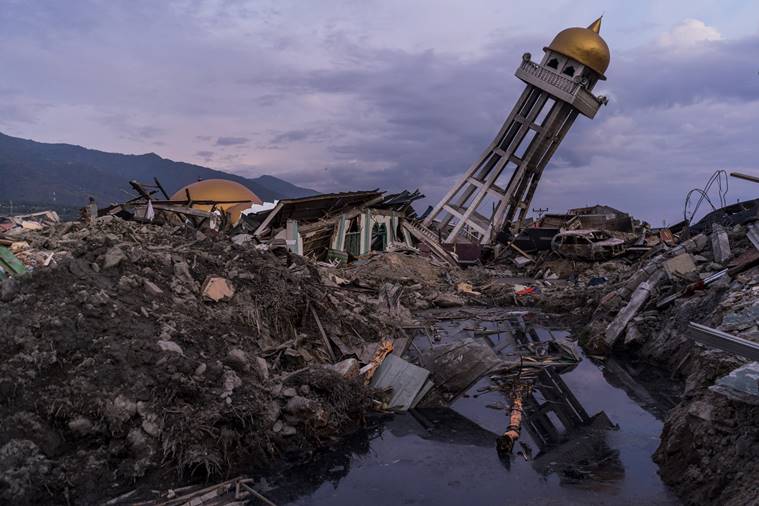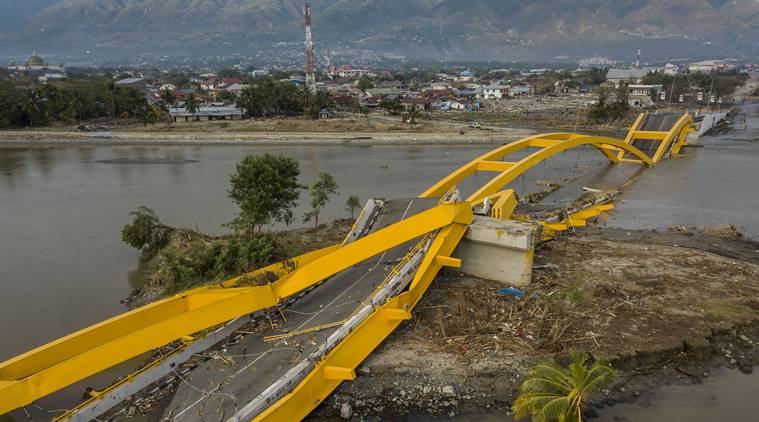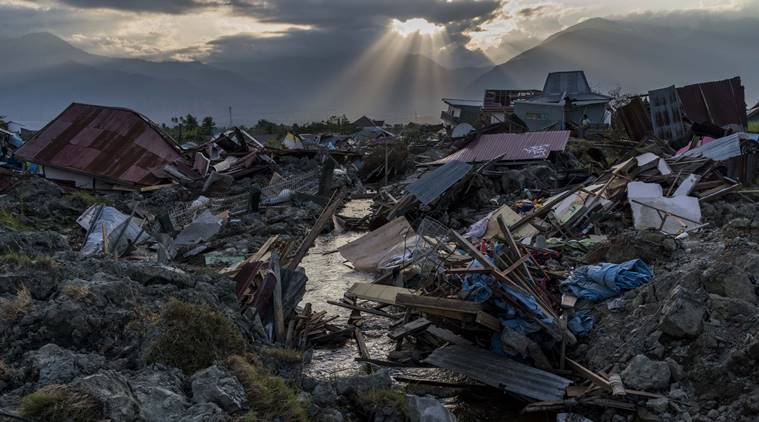 A woman looks through debris from the tsunami on Tasiburi beach near Palu, Indonesia. (Adam Dean/The New York Times)
A woman looks through debris from the tsunami on Tasiburi beach near Palu, Indonesia. (Adam Dean/The New York Times)
The sun was setting on the mosque in Sigi, and Randi Renaldi, 7, knelt and reached his fingers out in supplication. Then the ground beneath him juddered and swayed. The mosque crumpled, the dome came crashing down, and a concrete slab slammed down on Randi’s outstretched hands.
At the same moment in the same district on the central coast of Sulawesi Island, Priska Susanto, 15, had just finished praying on her first day of 10th-grade Bible camp. She was snacking on fried bananas at the Patmos church compound.
Here, the ground did not tremble as much as churn, melting into a terrifying sludge that heaved and dragged the church for a mile, and, finally, swallowed the building up to its roof and spire.
The starfish-shaped island of Sulawesi in Eastern Indonesia, which just a week ago suffered a 7.5-magnitude earthquake followed by a tsunami that crested over electricity poles, is a place of divided faiths. It is also a place where catastrophe after catastrophe, both natural and man-made, have been inflicted on Muslims and Christians alike.
In little more than half a century, Sulawesi has endured dozens of earthquakes, landslides, floods, tsunamis and volcanic eruptions; anti-communist pogroms that claimed at least half a million lives nationwide; and sectarian strife that culminated in the heads of schoolgirls deposited near a church and police station.
 A mosque damaged during last week’s earthquake in the Balaroa neighborhood of Palu, Indonesia. The earthquake and tsunami that devastated Indonesia’s Sulawesi Island struck a place where every kind of catastrophe — natural and man-made — has piled on, and help is far away. (Adam Dean/The New York Times)
A mosque damaged during last week’s earthquake in the Balaroa neighborhood of Palu, Indonesia. The earthquake and tsunami that devastated Indonesia’s Sulawesi Island struck a place where every kind of catastrophe — natural and man-made — has piled on, and help is far away. (Adam Dean/The New York Times)
At least 1,649 people have been confirmed killed by the twin natural disasters on Sept. 28. Many more are believed to have died, been buried under soil, swept away by waves or trapped in a tangle of crushed buildings that will take months, if not years, to clear.
Each day, dozens of corpses are stuffed into body bags and interred in mass graves. A week in the tropics means that expediency trumps ceremony.
For three days, the national disaster agency put the number of missing at an improbable 113. Suhri Noster Norbertus Sinaga, spokesman for the National Search and Rescue Agency, said that figure did not correspond with reality, as local officials had not yet provided any population data for affected areas.
Then, on Saturday, the estimate was increased to 256, and that, too, is unlikely to be anywhere near the final number. In just one of the neighborhoods visited by journalists for The New York Times, Petobo in the city of Palu, search and rescue workers estimated that thousands of people lay deep in the earth.
“We have only searched a small part of Petobo, and there are already so many bodies,” said Syamsul Rizal, head of a national search and rescue unit from southern Sulawesi.
At the collapsed church in Sigi, volunteers from the Indonesian Red Cross dug their shovels into layers of mud and rubble to extract the bodies. So far, 36 people, mostly children, have been confirmed killed when an earthquake-induced phenomenon called liquefaction transformed loose soil into a land tsunami.
The body of one girl at the Bible camp, Resky Senolingga, 15, was discovered nearly 10 miles away on the beach in Palu. No one is sure how she got there.
Nearly 60 children and teachers were still missing from the Christian camp, the Indonesian Red Cross said. As of Friday, their staff had only reached seven of the 15 subdistricts in Sigi — and the remaining eight were the more difficult to get to.
“Sulawesi is the place with the most complete disasters,” said Raman Kilo, a volunteer with the Indonesian Red Cross in northern Sulawesi, who was helping dig out the Bible camp.
Man’s response has exacerbated the crisis. In a place chronically at risk for tsunamis, no sirens or warnings sounded the evening that disaster struck.
Nearly a week after the quake and tsunami, Kartono, who goes by a single name, squatted in a sea of rubble near his destroyed home in Petobo, where 744 houses were inundated by liquefaction, according to Indonesia’s national disaster agency.
“Officials keep on coming to get my data but they still haven’t given me any aid,” Kartono said, smacking a chunk of asphalt to the ground, which was more than 30 feet higher than a week before. The quake sent houses rushing along rivers of mud and jumbled the local topography. Practically nothing that was left standing was where it had once been.
An archipelago of more than 13,000 islands, Indonesia is an unlikely nation. Dutch colonialists collected these islands peopled by hundreds of ethnic groups and united them for their abundance of natural resources, including spices and sugar, rubber and tobacco, coffee and an island of nutmeg trees considered so valuable it was traded in 1667 for Manhattan.
The sprawl of Indonesia notwithstanding, the center of gravity remains in Java, the small, densely populated island in the west of the country that includes the capital, Jakarta. Apart from a brief interregnum, no Indonesian from outside Java has led the country. The periphery, including Sulawesi, feels far away.
But Indonesia’s official excesses infected the whole country, most notably in 1965 and 1966, when an anti-communist purge by soldiers and paramilitaries led to at least half a million extrajudicial executions and possibly as many as 3 million deaths.
The massacres were largely ignored in the West, where a red scare was in full swing. Even today, many Indonesians considered communist sympathizers and other victims responsible for their own murders.
 A damaged bridge in the Balaroa neighborhood of Palu, Indonesia. The earthquake and tsunami that devastated Indonesia’s Sulawesi Island struck a place where every kind of catastrophe — natural and man-made — has piled on, and help is far away. (Adam Dean/The New York Times)
A damaged bridge in the Balaroa neighborhood of Palu, Indonesia. The earthquake and tsunami that devastated Indonesia’s Sulawesi Island struck a place where every kind of catastrophe — natural and man-made — has piled on, and help is far away. (Adam Dean/The New York Times)
During that purge, hundreds were persecuted here in Palu, according to a local human rights group, Solidarity for the Victims of Human Rights Violations. In 2012, Rusdy Mastura, then the mayor of Palu, the capital of Central Sulawesi province, apologized in his official capacity to their families. He also begged forgiveness for having guarded suspected communist prisoners when he was a Boy Scout.
Rusdy remains the only mayor in the country to have apologized for the anti-communist blood bath. No Indonesian president has formally expressed regret. More than half a century on, no truth and reconciliation commission has convened on Indonesian soil.
“It’s not hard to apologize,” Rusdy said. “There were many victims of human rights violations.”
Terror returned to Central Sulawesi province at the turn of this century when a minor conflict between a Muslim and Christian galvanized street battles by religious gangs armed with machetes and sharpened bamboo stakes. Thousands were killed on both sides.
Laskar Jihad, a militant group, began using nearby jungles as its hideout, arming Islamic paramilitaries to wage jihad with more potent weaponry.
Dozens of churches were attacked. In 2004, a female pastor leading a Sunday prayer service in Palu was shot in the back of the head. Two years later, another preacher, who had worked on interfaith dialogue, was shot by masked gunmen.
But both Muslims and Christians in Palu have been known to wonder whether the spate of natural disasters that the region has endured was the result of having disturbed older traditions than the Abrahamic faiths that came with Arab traders and European colonialists.
Last week’s tsunami deluged the opening ceremony of a 3-year-old cultural and adventure sports festival in Palu. City residents complained that the inclusion of an ancient healing ritual in the opening ceremony, a perversion of animist beliefs for a clearly commercial pursuit, has disturbed Sulawesi’s natural balance.
On the festival’s first opening day three years ago, crocodiles swarmed the bay. The next year, a typhoon raged. This year, the tsunami rolled in and swept away revelers and security guards.
 The remains of the Petoba neighborhood of Palu, Indonesia. The earthquake and tsunami that devastated Indonesia’s Sulawesi Island struck a place where every kind of catastrophe — natural and man-made — has piled on, and help is far away. (Adam Dean/The New York Times)
The remains of the Petoba neighborhood of Palu, Indonesia. The earthquake and tsunami that devastated Indonesia’s Sulawesi Island struck a place where every kind of catastrophe — natural and man-made — has piled on, and help is far away. (Adam Dean/The New York Times)
And there was more. On Wednesday, as residents of central Sulawesi were still digging through rubble and mud in a desperate search for survivors, Mount Soputan, in the island’s north, sent up a plume of ash 2.5 miles high. The eruption was a reminder that Sulawesi, like much of Indonesia, is perched on an arc along the Pacific Ocean named the Ring of Fire, the most seismically vigorous region on earth.
“Nature always gives its sign,” said Rusdy, Palu’s Muslim former mayor. “It doesn’t like being disturbed.”
When the mosque in Sigi, south of Palu, caved in a week ago, the chief of Bulubete village and one of his sons survived only because the dome fell on top of them and protected them in its space. The only other survivors were Randi and his two older brothers. Nineteen worshippers died.
Azar Aswad, Randi’s 14-year-old brother, had rushed out of the mosque when the tremors began and then returned to save his two siblings. The earthquake destroyed the roads out of the village so that it took two days to get Randi, with his injured hands, to the hospital in Palu. When the family arrived at the provincial hospital, doctors were still in triage mode, carrying out some operations with light from cellphones.
On Tuesday, the middle finger of Randi’s right hand was amputated to prevent infection from spreading. On Wednesday, his left hand was removed.
“Your fingers will grow back,” his father, Syarifudin, assured him. But the pain left Randi screaming.
“When we go home, I don’t want to ever go to the mosque again,” Randi told his mother, Sri Wahyuni.
While Indonesia is the world’s most populous Muslim-majority nation, around 10 percent of its population is Christian. And there is a larger than usual Christian community here at the center of the disaster zone.
The night of the earthquake, Naomi Susanto, the mother of Priska, the girl at the Bible camp, met with Agnes Payung, 15, one of her daughter’s best friends. Agnes and Priska were sitting together when the shaking began. Agnes scrambled through a side door and raced across an undulating landscape, jumping over cracks that formed in the ground.
The church behind her collapsed. Coconut trees snapped to the ground. Mud poured out of the fissures in the earth, sending buildings swimming past. Agnes crawled along the ground, the cold mud tugging at her clothes.
Along the way, she saw friends struggling through the surging muck. Priska’s mother, a Salvation Army preacher, wanted to know whether Priska was among them. She was not, Agnes said.
As they talked, Priska’s father and uncle returned from the site of the wrecked church where heavy equipment had begun mining the mud. Priska’s backpack and purse had been found. Inside were neatly folded clothes and a waterlogged Bible.
“It’s been a week and she’s still missing,” Naomi said. “But I’m praying and have hope.”